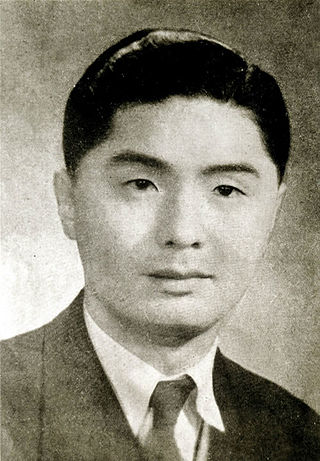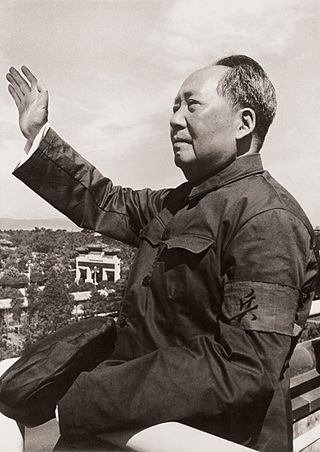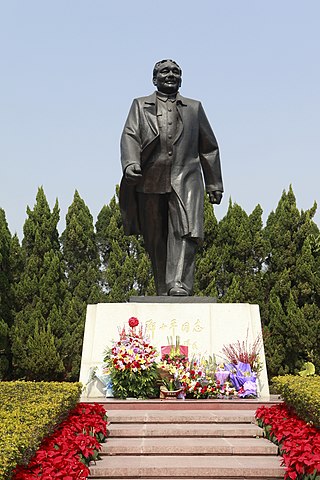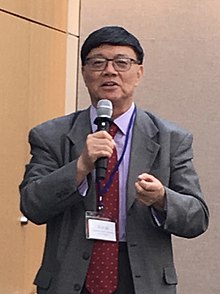
The Cultural Revolution, formally known as the Great Proletarian Cultural Revolution, was a sociopolitical movement in the People's Republic of China (PRC). It was launched by Mao Zedong in 1966 and lasted until his death in 1976. Its stated goal was to preserve Chinese socialism by purging remnants of capitalist and traditional elements from Chinese society. Though it failed to achieve its main objectives, the Cultural Revolution marked the effective return of Mao to the center of power in China after his political sidelining, in the aftermath of the Great Leap Forward and the Great Chinese Famine.
The Socialist Education Movement, also known as the Four Cleanups Movement was a 1963–1965 movement launched by Mao Zedong in the People's Republic of China. Mao sought to remove reactionary elements within the bureaucracy of the Chinese Communist Party (CCP), saying that "governance is also a process of socialist education."

Rong Yiren was the Vice President of China from 1993 to 1998 and was heavily involved with the opening of the Chinese economy to western investment. Rong is known both in China and in the Western world as "the Red Capitalist" because his family were some of the few pre-1949 industrialists in Shanghai to have been treated well by the Chinese Communist Party in return for their co-operation with the government of the People's Republic of China.
In the People's Republic of China since 1967, the terms "ultra-left" and "left communist" refers to political theory and practice self-defined as further "left" than that of the central Maoist leaders at the height of the Great Proletarian Cultural Revolution (GPCR). The terms are also used retroactively to describe some early 20th century Chinese anarchist orientations. As a slur, the Chinese Communist Party (CCP) has used the term "ultra-left" more broadly to denounce any orientation it considers further "left" than the party line. According to the latter usage, the CCP Central Committee denounced in 1978 as "ultra-left" the line of Mao Zedong from 1956 until his death in 1976. This article refers only to 1) the self-defined ultra-left of the GPCR; and 2) more recent theoretical trends drawing inspiration from the GPCR ultra-left, China's anarchist legacy and international "left communist" traditions.
The Stinking Old Ninth is a Chinese dysphemism for intellectuals used at two major points, the Yuan dynasty (1271–1368) and the Cultural Revolution (1966–1976).

Struggle sessions, or denunciation rallies or struggle meetings, were violent public spectacles in Maoist China where people accused of being "class enemies" were publicly humiliated, accused, beaten and tortured, sometimes to death, often by people with whom they were close. These public rallies were most popular in the mass campaigns immediately before and after the establishment of the People's Republic of China, and peaked during the Cultural Revolution (1966–1976), when they were used to instill a crusading spirit among crowds to promote Maoist thought reform.
The Daoxian massacre, or Dao County massacre, was a massacre which took place during the Cultural Revolution in Dao County, Hunan as well as ten other nearby counties and cities. From August 13 to October 17, 1967, a total of 7,696 people were killed while 1,397 people were forced to commit suicide. An additional 2,146 people were permanently injured and disabled. Most of the victims were labelled as "class enemies", belonging to the Five Black Categories, while at least 14,000 people participated in the massacre. The Daoxian massacre had a direct impact on the Shaoyang County Massacre in 1968.

The Guangxi Massacre comprised a series of lynchings and massacres in the Chinese province of Guangxi between 1967 and 1968, during the Cultural Revolution (1966–1976). The official record shows an estimated death toll between 100,000 and 150,000. Methods of murder included beheading, beating, live burial, stoning, drowning, boiling, and disembowelling.

The Inner Mongolia incident, or the Inner Mongolia People's Revolutionary Party purge incident, was a massive political purge which occurred during the Cultural Revolution in Inner Mongolia. The purge was supported by the Central Committee of the Chinese Communist Party and was led by Teng Haiqing, a lieutenant general of the People's Liberation Army. It took place from 1967 to 1969 during which over a million people were categorized as members of the already-dissolved Inner Mongolian People's Revolutionary Party (PRP), while lynching and direct massacre resulted in the deaths of tens of thousands, most of whom were Mongols.

Red August is a term used to indicate a period of political violence and massacres in Beijing beginning in August 1966, during the Cultural Revolution. According to official statistics published in 1980 after the end of the Cultural Revolution, Red Guards in Beijing killed a total of 1,772 people during Red August, while 33,695 homes were ransacked and 85,196 families were forcibly displaced. However, according to official statistics published in November 1985, the number of deaths in Beijing during Red August was 10,275.

The Zhao Jianmin spy case, or Zhao Jianmin wrong case, was a major fabricated spy case in Yunnan province during the Chinese Cultural Revolution, with more than 1.387 million people implicated and persecuted, which accounted for 6% of the total population in Yunnan at the time. From 1968–1969, more than 17,000 people died in a massacre while 61,000 people were crippled for life; in Kunming alone, 1,473 people were killed and 9,661 people were left disabled as a result.

The Daxing Massacre, also known as the Daxing Incident (大兴事件), was part of the Red August massacre in Beijing during the early Cultural Revolution. It took place in Daxing District of Beijing from August 27 to 31, primarily targeting members of the Five Black Categories. In total, 325 people were killed in the massacre by September 1, 1966; the oldest killed was 80 years old, while the youngest was only 38 days old; 22 families were wiped out.

The Violent Struggle, also known as Wudou or Factional Conflicts, refers to the violent conflicts between different factions during the Chinese Cultural Revolution (1966–1976). The factional conflicts started in Shanghai and Chongqing in December 1966, and then spread to other areas of China in 1967 which brought the country to the state of civil war. Most violent struggles took place after the power seizure of rebel groups, and gradually grew out of control in 1968, forcing the Central Committee of the Chinese Communist Party as well as the Chinese government to take multiple interventions in the summer of 1968.

The Shaoyang County Massacre, also known as the "Black Killing Wind" Incident, was a massacre in Shaoyang County of Hunan Province during the Chinese Cultural Revolution. According to the official statistics in 1974, from July to September of 1968, a total of 11,177 people were arrested with 7,781 imprisoned and 113 permanently disabled, while the death toll of the massacre was 991, including 699 who were forced to commit suicide. However, some researchers argue that thousands of people died in the massacre.

Boluan Fanzheng refers to a period of significant sociopolitical reforms starting with the accession of Deng Xiaoping to the paramount leadership in China, replacing Hua Guofeng, who had been appointed as Mao Zedong's successor before Mao's death in 1976. During this period, a far-reaching program of reforms was undertaken by Deng and his allies to "correct the mistakes of the Cultural Revolution", and restore order in the country. The start of the Boluan Fanzheng period is regarded as an inflection point in Chinese history, with its cultural adjustments later proven to be the bedrock upon which the parallel economic reform and opening up could take place. As such, aspects of market capitalism were successfully introduced to the Chinese economy, giving rise to a period of growth often characterized as one of the most impressive economic achievements in human history.

The Ruijin Massacre was a series of massacres that took place in Ruijin and nearby counties in Jiangxi Province during the Chinese Cultural Revolution. From September 23 to early October, 1968, over 1,000 people were killed in the Ruijin Massacre; specifically, over 300 people were killed in Ruijin County, around 270 were killed in Xingguo County, and over 500 in Yudu County.

The Guangdong Cultural Revolution Massacre was a series of massacres that took place in Guangdong Province of China during the Cultural Revolution. There were 80 counties in Guangdong during the Cultural Revolution, and according to the 57 county annals which became available during the "Boluan Fanzheng" period, massacres occurred in 28 of the counties with six counties recording a death toll of over 1,000—the average death toll among all the 28 counties was 278. The massacre in Yangjiang was the most serious, with over 2,600 deaths in Yangchun County alone. In addition, massacres also occurred in some cities of Guangdong; in the capital city Guangzhou, for example, the massacre targeting the prisoners of Laogai resulted in the deaths of at least 187–197 people within a week of August 1967.
The Seven-Thousand Cadres Conference was one of the largest work conferences ever of the Chinese Communist Party (CCP). It took place in Beijing, China, from 11 January to 7 February 1962. The conference was attended by over 7,000 party officials nationwide, focusing on the issues of the Great Leap Forward which resulted in the deaths of tens of millions in the Great Chinese Famine. CCP chairman Mao Zedong made self-criticism during the conference, after which he took a semi-retired role, leaving future responsibilities to Chinese President Liu Shaoqi and Vice Premier Deng Xiaoping.
Secret Archives about the Cultural Revolution in Guangxi, Classified Documents are official documents containing historical details about the Chinese Cultural Revolution (1966–1976) in Guangxi. The archives were originally composed by the Guangxi Zhuang Autonomous Regional Committee of the Chinese Communist Party in the 1980s, and were later published in the United States in 2016 and 2017 after being compiled by Chinese historian Song Yongyi and others. The main archives published in 2016 contain 36 volumes, and the supplements published in 2017 contain 10 volumes, giving a total of approximately 9 million word count in Chinese.
Massacres during the Cultural Revolution is a book by Chinese historian Song Yongyi. The book presents historical details together with author's analysis on a number of massacres which took place in mainland China during the Chinese Cultural Revolution (1966–1976). Originally published in Hong Kong in 2002, the book was later translated into French and was published in France in 2008.












